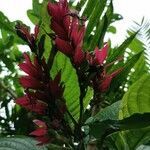Shrub to 4 m tall; stems subquadrangular, sparingly puberulous. Leaves elliptic, to 24 cm long and 10.5 cm wide, apically acuminate with a rounded, apiculate tip, basally acute, sparingly strigose on the costa and the lateral veins of both surfaces, the cystoliths none, the margins entire to crenulate; petioles puberulous, to 2 cm long. Inflorescences in clustered, loose, terminal spikes, the spikes to 19 cm long and 4 cm wide, the peduncle brown puberulous, to 3.5 cm long, the rachis brown puberulous, terete, the bract solitary, ovate to elliptic, to 3.5 cm long, 2 cm wide, apically acute, basally acute, deep red, drying to reddish brown, sparingly strigulose on both surfaces, mostly restricted to the costa, the margins entire; bractlets elliptic, to 20 mm long, 5 mm wide, apically acute, basally attenuate, sparingly strigulose. Flowers with the calyx segments equal, lanceolate, to 10 mm long, 2 mm wide at base, densely strigose; corolla white, tube cylindrical, to 25 mm long, 2 mm wide, pilosulous, the upper lip lanceolate, to 35 mm long, 5 mm wide basally, apically bilobed, the lobes subulate, 1.5 mm long, 0.5 mm wide at the base, the lower lip elliptic, 35 mm long, 8 mm wide, pilosulous outside, apically 3-lobed, the lobes lanceolate, 7 mm long, 2 mm wide at base; stamens exserted ca. 3 cm beyond throat of the corolla, the filaments glabrous, the anthers 4.5 mm long, 1.5 mm wide, basally mucronate; ovary 2 mm long, glabrous; capsules clavate, to 30 mm long, 8 mm wide, apically at-tenuate and mucronate, glabrous; seeds 4, suborbiculate, flattened, ca. 6 mm in diameter, glabrous.
More
Suffruticose, to 3 m tall. Stem quadrangular, brown-puberulous, much-branched at base. Leaf blade oblong, to 19 x 7 cm (lowermost probably larger), short-acuminate, cuneate at base, rather firm, entire or undulate, both surfaces sparingly and minutely hirtellous, trichomes confined to primary and secondary veins (12-15 pairs), cystoliths none. Spikes solitary, terminal to 18 x 4 cm, peduncle (ca. 3.5 cm long) and rachis brown-puberulous; bracts ovate, 30-44 x 11-17 mm, subobtuse and mucronulate at apex, narrowed at base, dark pink, purple or red, sparingly and finely strigose; bracteoles ovate-lanceolate, subfalcate, to 36 x 8 mm, acute, pubescence similar to bracts. Calyx lobes lanceolate, to 15 x 3 mm, narrowed to a slender, blunt tip, rather densely hirsute, trichomes curved, brown, vitreous, some of the shorter ones gland-tipped; corolla white distally, grading to dark pink proximally, pilosulous, trichomes mostly retrorsely curved, white, corolla tube ca. 22 x 2-3 mm, straight or slightly curved, upper lip lanceolate, 36 x 5 mm, 2-lobed, lobes oblong, 1.5 x 0.5 mm, recurved, lower lip narrowly cuneate, 32 x 9 mm, 3-lobed, lobes 7 x 3 mm, obtuse; stamens exserted ca. 30 mm beyond mouth of corolla tube, anthers 4.5 x 1.5 mm, base of thecae mucronulate; ovary 2 mm long, glabrous. Capsule clavate, 35 x 9 x 7 mm, glabrous, stipe 20 x 5.5-6 mm; retinacula 4 mm long, flat and truncate at tip; seeds suborbicular, ca. 6 mm in diam., flattened, yellowish-brown, glabrous.

